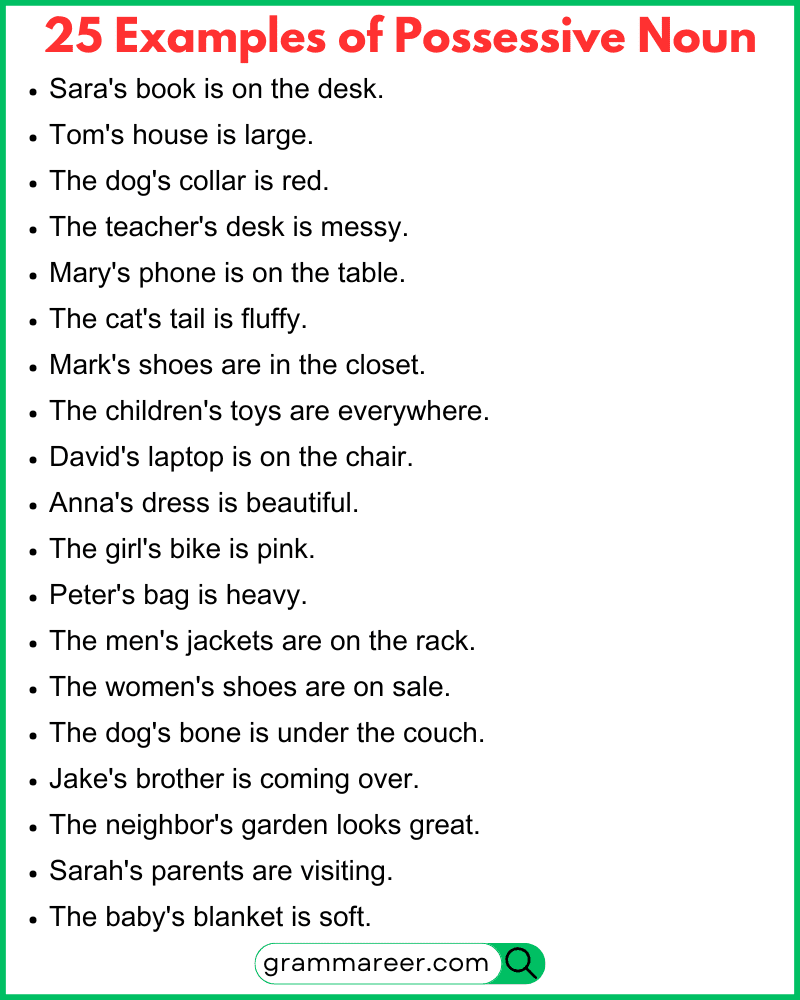A possessive noun is a noun that shows ownership or possession. It is used to indicate that something belongs to someone or something. Possessive nouns are typically formed by adding an apostrophe (‘) or an apostrophe and “s” (‘s) to the noun. For example, “Ahmed’s car” shows that the car belongs to Ahmed. These nouns are an essential part of English grammar and help convey relationships between objects, people, and ideas clearly and concisely. Understanding possessive nouns is key to enhancing your writing and communication skills.
A possessive noun shows ownership, formed by adding ‘s or just an ‘ to a noun.
Table of Contents
Examples of Possessive Nouns
- Fatima’s bag is on the chair.
- The bird’s wings were colorful.
- The teacher’s advice was helpful.
- The players’ jerseys were bright.
- The parents’ meeting is scheduled for tomorrow.
- The workers’ tools were left outside.
- The children’s toys were scattered everywhere.
- The men’s jackets were on the rack.
- The women’s shoes are displayed in the window.
- Zaid’s camera is expensive.
- The store’s hours are posted on the door.
- Ahmed’s cousin is visiting from abroad.
- My sister-in-law’s dress is beautiful.
- The teachers’ lounge is spacious.
- The boys’ basketball game was exciting.
- The cat’s whiskers are long.
- The people’s decision was unanimous.
- The dog’s collar is red.

Possessive Noun vs. Possessive Pronoun
Though similar, possessive nouns and possessive pronouns serve different roles. A possessive noun uses a noun to show ownership, while a possessive pronoun replaces the noun.
| Aspect | Possessive Noun | Possessive Pronoun |
|---|---|---|
| Definition | Shows ownership with a noun | Replaces a noun to show ownership |
| Examples | Zainab’s dress | Hers |
| Usage | Requires an apostrophe | Does not use an apostrophe |
For example:
- Possessive noun: Bilal’s bike is new.
- Possessive pronoun: The new bike is his.
Types of Possessive Noun
Understanding these types helps in correctly identifying and forming possessive nouns.
1. Singular Possessive Noun
Formed by adding ‘s to a singular noun.
Examples:
- Ali’s book is on the table.
The book belongs to Ali.
- The cat’s whiskers are long.
The whiskers belong to the cat.
2. Plural Possessive Noun
Formed by adding only an apostrophe (‘) to plural nouns ending in “s.”
Examples:
- The players’ jerseys are colorful.
The jerseys belong to the players.
- The parents’ meeting is tomorrow.
The meeting belongs to the parents.
3. Irregular Plural Possessive Noun
Formed by adding ‘s to irregular plural nouns.
Examples:
- The children’s books are on the shelf.
The books belong to the children.
- The men’s jackets are on the rack.
The jackets belong to the men.
How Are Possessive Nouns Used in Sentences?
Possessive nouns can be used in various ways to enhance sentence clarity:
1. To Show Ownership:
Examples:
- Zaid’s camera is expensive.
The camera belongs to Zaid.
- The store’s hours are posted on the door.
The hours belong to the store.
2. To Describe Relationships:
Examples:
- Ahmed’s cousin is visiting from abroad.
The cousin shares a familial relationship with Ahmed.
- The doctor’s assistant is very helpful.
The assistant works for the doctor.
3. With Compound Nouns:
Examples:
- My sister-in-law’s dress is beautiful.
The dress belongs to the sister-in-law.
- The mother-in-law’s advice was insightful.
The advice belongs to the mother-in-law.
Using possessive nouns effectively allows you to convey ownership and relationships concisely.
Rules of Possessive Nouns
- For singular nouns, add ‘s:
✅ Sara’s idea was brilliant.
❌ Sara idea’s was brilliant.
- For plural nouns ending in “s,” add only an apostrophe:
✅ The cats’ food is in the bowl.
❌ The cats’s food is in the bowl.
- For irregular plural nouns, add ‘s:
✅ The children’s park is nearby.
❌ The childrens’ park is nearby.
- For compound nouns, add ‘s to the last word:
✅ My brother-in-law’s car is parked outside.
❌ My brother’s-in-law car is parked outside.
- Avoid confusing possessive nouns with plurals:
✅ The dog’s collar is red. (ownership)
❌ The dogs collar is red. (plural without possession)
Following these rules helps in maintaining grammatical accuracy and clarity in your writing.
FAQs
A possessive noun shows ownership or possession, often formed by adding ‘s or an apostrophe. For example, “Amina’s book” means the book belongs to Amina.
The men’s jackets were on the rack.
Add an apostrophe to plural nouns ending in “s” (e.g., “cats'”) or add ‘s to irregular plural nouns (e.g., “children’s”).
Possessive nouns use an apostrophe with a noun (e.g., “Ali’s”), while possessive pronouns replace the noun and don’t use an apostrophe (e.g., “his”).
Yes, it can describe relationships or characteristics, such as “the city’s skyline,” which indicates a feature of the city.
Common mistakes include misplacing the apostrophe (e.g., “dogs’s” instead of “dogs'”) or confusing plural and possessive forms (e.g., “teachers” vs. “teacher’s”).
Conclusion
Mastering possessive nouns is vital for expressing ownership and relationships clearly in English. By understanding their formation, usage, and types, you can create precise and meaningful sentences. Practice regularly to avoid common mistakes and improve your grammar skills.
You May Also Like





